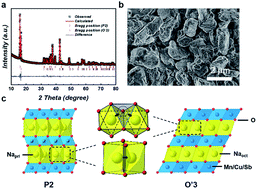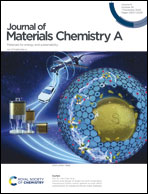Integrating P2 into O′3 toward a robust Mn-Based layered cathode for sodium-ion batteries†
Abstract
Manganese-based layered cathode materials for sodium-ion batteries are attractive on account of the superiorities of high capacity and cost effectiveness. Nevertheless, the materials suffer from sluggish kinetics and drastic volume changes during the extraction and insertion of Na ions, thereby resulting in inferior rate capability and rapid cycling decay. Herein, a strategy of integrating structurally stable P2 into the O′3 phase for robust Mn-based layered oxides is proposed, which not only buffers the drastic lattice strain, but also enhances Na-ion diffusion. The P2/O′3-biphasic NaMn0.89Cu0.08Sb0.03O2 cathode provides a high reversible capacity of 204 mA h g−1, an admirable capacity retention of 80% after 150 cycles and a superior rate capability with 120 mA h g−1 capacity at 2C rate, in stark contrast to O′3 NaMnO2. The results show that the volume change and lattice parameter c have been respectively reduced to 10.5% and 3.3% after P2 integration, compared with 27.04% and 23.39% for the original O′3 NaMnO2, and the Na-ion diffusion coefficient has been evidently increased from 10−12 in the pristine O′3 NaMnO2 to 10−11 in the P2/O′3 biphase. The findings highlight the significance and superiority of the composite electrode and provide new insights for the rational design of high-performance sodium-ion batteries.



 Please wait while we load your content...
Please wait while we load your content...